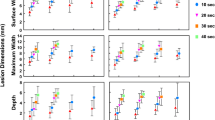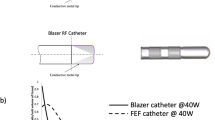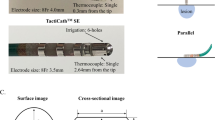Abstract
Since myocardial lesion size during radio-frequency (RF) ablation is limited at high power by impedance rise when electrode tip temperature exceed 100 °C, controlling tip temperature by continuous intraelectrode saline infusion could permit generation of larger lesion. (1) Two dogs randomly received either standard or cooled tip RF ablation at 4 to 6 separate LV sites. Power output of 30 W was delivered via modified 7 Fr deflectable catheter with 4 mm tip for up to 120 sec or until impedance rise occurred. (2) Six dogs randomly received cooled tip RF ablation at power output of 20, 30, 40 W for 120 sec. (3) Three dogs randomly received cooled tip RF ablation using room temperature saline (21–25 °C) or chilled saline (1–4 °C) infusion.
Results: Overall, peak tip temperature was lower for cooled vs standard RF deliveries (97±17 °C vs. 42±8 °C). Lesion depth and volume were significantly larger for cooled burns. Lesion depth and volume and the incidence of abrupt impedance rise/popping did not differ between room temperature saline and chilled saline infusion. The catheter-tip temperature at the onset of popping and abrupt impedance rise was 54±5 °C(48–60 °C) and 59±10 °C(50–75 °C).
Conclusion: Cooled tip RF current delivery at high power is associated with increased myocardial lesion size which may facilitate successful ablation of ventricular tachycardia associated with acquired structural heart disease. Catheter-tip temperature should be maintained below 45 °C to prevent popping and abrupt impedance rise during RF energy delivery.
Similar content being viewed by others
References
Simmers TA, Wittkampf FHM, Hauer RNW, et al. In vivo ventricular lesion growth in radiofrequency catheter ablation. PACE 1994; 17: 523–531.
Fitzgerald DM, Friday KJ, Yeung Lai Wah, et al. Myocardial regions of slow conduction participating in the reentrant circuit of multiple ventricular tachycardias: report on ten patient. J Cardiovasc Electrophysiol 1991; 2: 193–206.
Morady F, Harvey M, Kalbfleisch SJ, et al. Radiofrequency catheter ablation of ventricular tachycardia in patients with coronary artery disease. Circulation 1993; 87: 363–372.
Kim YH, Sosa-Suarez G, Trouton TG, et al. Treatment of ventricular tachycardia by transcatheter radiofrequency ablation in patients with ischemic heart disease. Circulation 1994; 89: 1094–1102.
Littmann L, Svenson RH, Gallagher JJ, et al. Functional role of the epicardium in postinfarction ventricular tachycardia: observations derived from computerized epicardial activation mapping, entrainment, and epicardial laser photoablation. Circulation 1991; 83: 1577–1591.
Downer E, Kimber S, Harris L, et al. Endocardial mapping of ventricular tachycardia in the intact human heart, II: evidence for multisite reentry in a functional sheet of surviving myocardium. J Am Coll Cardiol 1992; 20: 869–878.
Simmers TA, Wittkamp FHM, Hauer RNW, et al. In vivo ventricular lesion growth in radiofrequency catheter ablation. PACE 1994; 17: 523–531.
Wittkamp FHM. Temperature response in radiofrequency catheter ablation. Circulation 1992; 86: 1648–1650.
Ring ME, Huang SKS, Gorman Gey, et al. Determinants of impedance rise during catheter ablation of ventricular myocardium. Circulation 1990; 82: 1034–1038.
Jackmann WM, Kuck KH, Naccareli GV, et al. Radiofrequency current directed across the mitral annulus with a bipolar epicardial-endocardial catheter electrode configuration in dogs. Circulation 1988; 78: 1288–1298.
Hains DE, Verow AF. Observations on electrodetissue interface temperature and effect on electrical impedance during radiofrequency ablation of ventricular myocardium. Circulation 1990; 82: 1034–1038.
Wittkamp FHM, Hauer RN, Robles de Medina EO. Radiofrequency ablation with a cooled porous electrode catheter. J Am Coll Cardiol 1988; 11: 17 (abstract).
Huang SKS, Cuenoud H, Tan de Guzman W. Increase in the lesion size and decrease in the impedance rise with saline infusion electrode catheter for radiofrequency catheter ablation. Circulation 1989; 80: II-324 (abstract).
Bergau D, Brucker GG, Saul JP. Porous metaltipped catheter produces larger radiofrequency lesions through tip cooling. Circulation 1993; 88: I-64 (abstract).
Nakagawa H, Yamanashi WS, Pitha JV, et al. Comparison of in vivo tissue temperature profile and lesion geometry for radiofrequency ablation with a saline-irrigated electrode versus temperature control in a canine thigh muscle preparation. Circulation 1995; 91: 2264–2273.
Nibley C, Sykes CM, Chapman T, et al. Prevention of impedance rise during radiofrequency current catheter ablation by intra-electrode tip cooling. Circulation 1994; 90: I-271 (abstract).
Ring ME, Huang SKS, Gorman G, et al. Determinants of impedance rise during catheter ablation of bovine myocardium with radiofrequency energy. PACE 1898; 12: 1502–1513.
Langberg JJ, Calkins H, El-Atassi R, et al. Temperature monitoring during radiofrequency catheter ablation of accessory pathways. Circulation 1992; 86: 1464–1474.
Mittleman RS, Huang SKS, De Guzman WT, et al. Use of the saline infusion electrode catheter for improved energy delivery and increased lesion size in radiofrequency catheter ablation. PACE 1995; 18: 1022–1027.
Ruffy R, Imran MA, Santel DJ, et al. Radiofrequency delivery through a cooled catheter tip allows the creation of larger endomyocardial lesions in the ovine heart. J Cardiovasc Electrophysiol 1995; 6: 1089–1096.
Nibley C, Sykes CM, Rowan R, et al. Predictors of abrupt impedance rise during chilled-tip radiofrequency catheter abrupt impedance rise during chilledtip radiofrequency catheter ablation. JAmColl Cardiol 1995; Feb:293A (abstract).
Wharton JM, Nibley C, Sykers, et al. Establishment of a dose-response relationship for higher power chilledtip radiofrequency current ablation in sheep. J AmColl Cardiol 1995;Feb:293A (abstract).
Skrumeda LL, Mehra R. Comparison of standard and irrigated radiofrequency ablation in the canine ventricle. J Cardiovasc Electrophysiol 1998; 9: 1196–1205.
Petersen HH, Chen X, Petersen A, et al. Tissue temperature and lesion size during irrigated tip catheter radiofrequency ablation. PACE 200; 23: 8–17.
Calkins H, Epstein A, Packer D, et al. Catheter ablation of ventricular tachycardia in patients with structural heart disease using cooled radiofrequency energy. JAm Coll Cardiol 2000; 35: 1905–1914.
Petersen HH, Chen X, Petersen A, et al. Temperaturecontrolled irrigated radiofrequency catheter ablation: comparison of in vivo and in vitro lesion dimensions for standard and irrigated tip catheter with minimal infusion rate. J Cardiovasc Electrophysiol 1998; 9: 409–414.
Nakagawa H, Wittkampf FHM, Yamanashi WS, et al. Inverse relationship between electrode size and lesion size during radiofrequency ablation with active electrode cooling. Circulation 1998; 98: 458–465.
Jais P, Haissaguerre M, Shah DC, et al. Successful irrigated-tip catheter ablation of atrial flutter resistant to conventional radiofrequency ablation.
Jais P, Shah DC, Haissaguerre M, et al. Prospective randomized comparison of irrigated-tip versus conventional-tip catheters for ablation of common flutter. Circulation 2000; 101: 772–776.
Wong WS, VanderBrink BA, Riley RE, et al. Effect of saline irrigation flow rate on temperature profile during radiofrequency ablation. J Intervent Cardiac Electrophysiol 2000; 4: 321–326.
Delacretaz E, Stevenson WG, Winters GL, et al. Ablation of ventricular tachycardia with a saline-cooled radiofrequency catheter: anatomic and histologic characteristic of the lesions in humans. J Cardiovasc Electrophysiol 1999; 10: 860–865.
Author information
Authors and Affiliations
Corresponding author
Rights and permissions
About this article
Cite this article
Watanabe, I., Masaki, R., Min, N. et al. Cooled-Tip Ablation Results in Increased Radiofrequency Power Delivery and Lesion Size in the Canine Heart: Importance of Catheter-Tip Temperature Monitoring for Prevention of Popping and Impedance Rise. J Interv Card Electrophysiol 6, 9–16 (2002). https://doi.org/10.1023/A:1014140104777
Issue Date:
DOI: https://doi.org/10.1023/A:1014140104777




